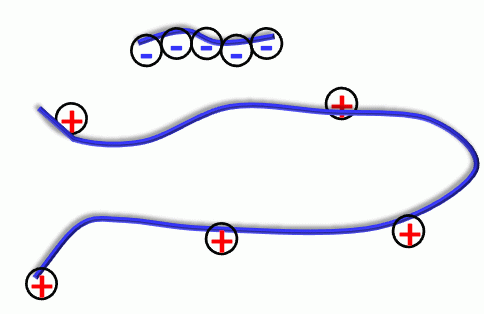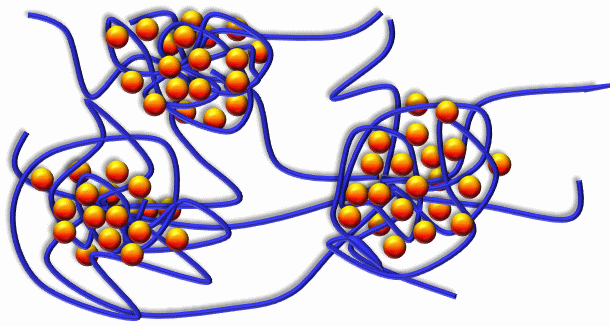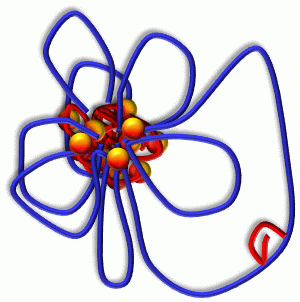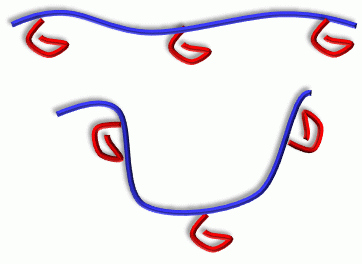Main » Fields of research
One of the possibilities to form a stable aggregate is the complexation of charges of opposite sign. They are used for the delivery of charged chemicals as well as for specific binding to charged target  s on the cell membranes. Usually the drug carrier designed for the delivery of a charged polymer is composed of a diblock copolymer: one block is charged and forms a complex with the drug while the other block is neutral and is devised to form the corona around the aggregate, aiming at shielding the complex from the solution.
|
 The most promising drug delivery systems are based on degradable physical gels. The target is the control of the gel architecture: structure and size of crosslinks, the distances between the hydrophobic nuclei that will store the drug, the strength of the drug binding, the drug partition coefficient and diffusion coefficients. The control of these variables will allow for a fine tuning and adjustment of the release rate and drug density profile inside the gel for a given particular need. Such modeling problems are not yet solved except in several empirical models, only suitable for one particular system. Any qualitative knowledge as well as any modeling tool will have a high impact in this domain. These gels are designed for prolonged delivery of drugs and there is a strong industrial need for a further development of this theoretical method. The system of particular interest is hydrogels PEO-PLA-PEO, where the cores of the gels are formed of Poly-Lactic acid, degrading under physiological conditions to metabolites.
|
 Often the polymeric drug carriers in the assembled state are more toxic for cells than when in a dissociated state. The reasons of this significant increase of toxicity for the cell when assembled as well as the ways to reduce it are still unknown. Although the increased toxicity is sometimes attributed to the ability of the drug carriers to dissolve membrane lipids in the carrier cores, this remains as a speculative idea. During the contact with cell membranes the drug carriers may suck phospholipids and other constituents of cells into the cores, thus irreversibly damaging them. We investigate this problem with the Self-Consistent Mean Field Theory. The result of our analysis will elucidate the real effect of the aggregate on the cell membrane and give a comprehensive explanation of the increase of the toxicity, thus opening the door to strategies to reduce such toxicity.
|
The binding of the drug to the micelles described above is not very strong and the micelles normally dissociate when the bulk polymer concentration is below the CMC. This can be viewed as a disadvantage in some applications. If a stronger binding is required, the hydrophobic drug can be chemically attached to a hydrophilic linear polymer, as a side chain. Such a structure is known as a prodrug or polysoap. In an aqueous solution, the sid  e chains containing drug form the core of the micelle, while the  hydrophilic main chain forms the corona, mostly comprising loops. Such an aggregate is more stable than the simple micelle and does not release the drug until a chemical signal is given, for example, enzymatic degradation of the main chain at the target site. Since the only existing models are phenomenological models of polysoaps, the SCMFT method provides an important alternative that promises to give new and detailed information out of the reach for current capabilities.
|
Block copolymer micelles are composed of polymer chains with sequences of hydrophilic and hydrophobic blocks. In a dilute aqueous solution, they form spherical or cylindrical nano-objects comprised of several chains with a hydrophobic core and extended hydrophilic  corona. Lipophilic drugs can be dissolved in the core of these micelles, while the corona will assure solubility of this nano-container in aqueous media. In addition, if the corona is composed of a block which does not induce the immune reaction (for example PEO) the interior of the micelle will be invisible to the immune system. Such systems are extensively studied experimentally. The questions that can be answered within the SCMFT method include: the critical micellar concentration (CMC) of the aggregates, the region of stability of micelles, the maximal load of drug as a function of a chain architecture, the equilibrium sizes and size distributions of micelles loaded with and without drug. Finally, we can predict the release rate of the active component, modifying the method in line with the Dynamic Density Functional Theory (DDFT) using the local variations of the SCMF free energy as the thermodynamic force causing the material flow. We are constantly looking for practical applications of our theory. The architecture of the primary sequence of the block copolymer can be altered in order to achieve desired properties. For example, this is the case in the so-called scorpion-like surfactants, where the hydrophobic block is constructed from two stiff units composing a fixed angle. Such a structure allows for more space inside the core of the micelle to carry a lipophilic drug, thus increasing the load of drug per micelle.
|
We explore the capabilities of the Single Chain Mean Field Theory (SCMFT) developed at the URV in direct applications to the design and conception of drug carriers. The method is very competitive when compared to Monte Carlo simulations and is therefore suited for an exhaustive exploration of the compositions and molecular structures, such as those required to properly tune the properties of drug carriers. This computational method best suits the purposes of this area, since it can describe such nanoscale objects including details at the molecular level. In addition, we hope to fill with this comprehensive method the huge lack of even qualitative modeling in the domain of drug carriers. 
The method exactly accounts for the configurations of a single microscopically detailed chain at the molecular level. The interactions between different chains are described self-consistently through a mean molecular field. This mean field is found self-consistently. This method can be applied to solutions of linear or branched polymers, solutions of low-molecular weight surfactants and various additives, and mixtures of various components. It can be extended for the description of ordered phases, like liquid crystals, and to disordered structures as gels. The methodology of the SCMFT by its construction can be especially successful when used in parallel for the description of nano-objects like polymeric drug carriers.(Read more)
| |
|
|
|
